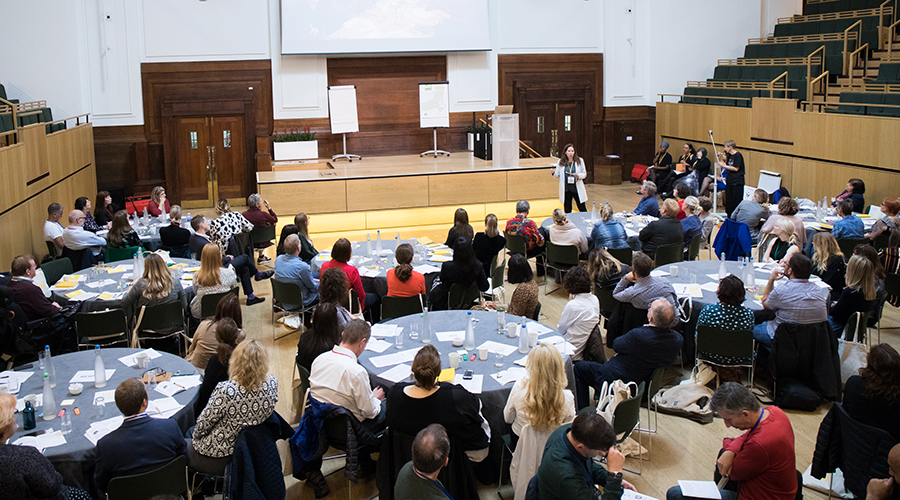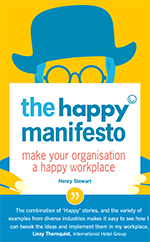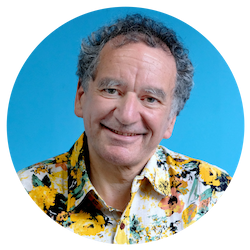49 Steps to a Happy Workplace
At the 2019 Happy Workplaces Conference, our seventh annual event in London, a range of fabulous speakers shared ideas on how to create great workplaces based on trust and freedom.
In this blog, Henry lists 49 of his favourite ideas from the event.
Hi, we are Happy
We are leading a movement to create happy, empowered and productive workplaces.
How can we help you and your people to find joy in at least 80% of your work?

Cathy Busani, Managing Director at Happy, @HappyLtd
Cathy is Managing Director of Happy and has worked for the company for 25 years. She loves coaching and supporting people and enabling them to be the best version of themselves.
1. Find joy at work: "At Happy our aim is that very body has joy in their work for 80% of their time. We measure it and are currently at 73%." What brings you joy at work?
2. Find your strengths: "What, last week, did you look forward to, helped you stay inquisitive, and left you feeling magnificent? That is where to find your strengths."
3. Throw away the job descriptions: Instead of sticking to job descriptions, try throwing the jobs in the air. Ask what people love doing and what they are good at. And switch the roles.
4. Get rid of appraisals: "We replaced them with a four-monthly check in. People describe their successes and aspirations, their radical disruption, what % of time work gives you joy."
5. Do what you are best at each day: Gallup asked over a million people "do you get to do what you are best at each day." In the UK just one in six said yes. But those organisations where people did get to do what they are best at were over 30% more productive.
Rosie Brown, MD, Cook, @theCOOKkitchen
Rosie is co-CEO of COOK, which makes remarkable frozen food in their own kitchens in Sittingbourne in Kent, made like you would at home. Cook employs over 900 people, is a founding UK BCorporation (people using business as a force for good) and were voted No 14 in the Sunday Times Top 100 Best Companies this year, the highest placed manufacturing company.
6. Food and relationships: "Company is rooted in the Latin ‘com panis’ which means ‘with bread’. It's all about relationships."
7. It's all about relationships: "Our sense of happiness and fulfilment across life depends on the quality of our relationships. Relationships drive business performance. We have 90 shops and the best performance comes from those with the best relationships."
8. Build the relationships: "We got lots of advice on how to scale the business but none on how to scale our relationships. Good relationships at work make you feel trusted, respected, understood, empowers, supported, appreciated, energised."
9. The key elements of good relationships at work: Clarity, Common Purpose and Appreciation.
10. Help your people’s dreams come true: "At COOK, we have the Dream Academy to help our people achieve their personal dreams. Dream It. Plan it. Do It." More here.
11. Go for a walk: "Building relationships doesn’t need to cost a fortune. We have ideas like 'Go and have a meeting walking on the South Downs'."
Tracey Waters, Head of People Experience at Sky UK
Tracey is Head of People Experience and Development at Sky UK. Her experience in learning, leadership and talent spans nearly 15 years. With a Masters degree in Clinical Psychology, she is on a mission to help Sky become a 21st century organisation and is a passionate advocate of utilising Agile to achieve this.
12. Let’s put the human back into HR: "My test for HR policies and activities: Are they useful? Are they simple? Are they enjoyable?"
13. Appraisals don't help: "Traditional performance appraisals are so bad that they actually make performance worse about one-third of the time." (Quoting this from Gallup)
14. Produce an MVP: "In the past I've been great at telling people to wait while I build them something bright and shiny. Now I produce an MVP - minimum valuable product (not minimum viable product). Don't build them a car when all they need is a skateboard."
15. Ask 'how might we...': "it enables very different answers to ‘what can we'."
16. It's time for EX: "We all know about CX (customer experience) and UX (user experience). Now we need EX (employee experience). How do we make sure our employees are delighted?"
17. Ask four design thinking questions: What is? What if? What wows? What works?
18. Use Design Thinking and Agile in HR: Find solutions based on your people, that work for your people.
Traci Fenton, CEO, WorldBlu, @tracifenton
Traci Fenton — here all the way from Boulder, Colorado — is the founder and CEO of WorldBlu. WorldBlu organise global awards, seeking to find the most democratic and freedom-based organisations across the world. Traci was recently recognised by Inc. Magazine as a Top 50 Leadership Thinker along with other world-class leaders such as Dan Pink and Brené Brown.
19. Vote on key decisions: "The 55,000 strong healthcare company Davita puts democracy into practice by having staff vote on key decisions."
20. Let people choose their manager: "75% of people who voluntarily leave a company do so because of their manager. Happy solves that by letting people choose their manager."
21. Practice democracy at work: Democracy is creating an environment where people can realise their fullest potential. We need freedom centred workplaces.
22. Tackle the systems: 75% of what drives your culture is your systems and processes. To build a world class culture you need to build democratic systems.
Derek Hill, MD, ATS, @Derek_ATSUK
Derek has been Managing Director of Advanced Technology Solutions for 8 years. Advanced Technology Solutions have been on a journey over the last few years towards creating a truly great workplace. "We make factories run better."
23. The role of the manager is to coach: "What has Happy brought us? We've moved from management to coaching, from induction to reinforcement, from outcomes to intent: have I done my best?"
24. Try two-minute Tuesday: "Every Tuesday I record a two-minute video on what's going on, and distribute it to all our people. The good stuff and the difficult stuff."
25. Enable job ownership: Create Freedom within Guidelines. Set the framework and then let people make their own decisions.
26. Beware the culture iceberg: Beneath the visible values are a set of underlying assumptions.
27. It's about Solidarity as well as Sociability: Sociability brings enjoyment, creativity and effort. Solidarity brings focus, urgency and achievement.
28. Find purpose and passion: "Fear-based leadership leads to command and control. Freedom based leadership leads to empowered workplaces. It’s not about ping pong and perks. It's about purpose and passion."
29. Stop the inductions: "We stopped inducting people. Instead we got them to meet with their colleagues to share what you need to do to succeed and survive."
Sarah Metcalfe, Sureflap and Happy Coffee Consulting, @SurePet_Sarah
Originally from Canada, Sarah has trained with Happy, and Woohoo! in Copenhagen and is a certified Chief Happiness Officer. As well as now setting up her own consulting company Happy Coffee Consulting, Sarah has been Head of Customer Service for Sure Petcare for many years – a company whose customer ratings are out of this world.
30. Engage with your people: Take five minutes each day speak to a different member of staff. Ask what can I do for you?
31. The 20 second rule: "If something is making your life or your customers life 20 seconds harder, stop it."
32. What makes us happy at work? "Doing great work with great people. It's about results and relationships."
33. Let people do their jobs: "What makes my people happy? Turns out it's what I don’t do. I don't hassle people. I don't measure them. I let them do their job."
34. We still need people: Sarah quoted from Tom Friedman on AI: "We used to work with our hands, now we work with our heads, in the future we will work with our hearts — and machines will never have hearts."
35. Things to stop doing: Sending so many emails; micro-managing; trying to make everybody happy.
36. Let your front-line staff decide: Avoid the iceberg of ignorance (decisions made by senior leaders remote from the customer). Ensure decisions are made where the information is, at the front-line.
Alison Sturgess Durden, Director, Mayden, @asturgessdurden
Alison, once an NHS manager, is now Director of Mayden and is "changing what's possible for clinicians and patients with insightful information technologies." Mayden is a software company based in Bath, which doesn't have managers.
37. Do you need to be managed? "How many of you are managed?" Most people put their hands up. "How many of you feel you need to be managed?" Nobody put their hands up. "Why do we assume people need managing?"
38. The key role of the manager: "I see 99% of my job as getting out of the way. Help set the direction, give assurance and then get out of the way."
39. Use peer feedback: "Research has shown peers have twice as much impact as anything your manager does."
40. An organisational chart with a difference: The organisational chart at Mayden has no hierarchy and no line management. Instead it's about self-managing teams.
41. Make your own decisions: "We have a clear protocol, the 11 Cs of decision making, which help people make their own decision."
42. No blame: Have a genuine no blame culture where mistakes are a chance to learn.
43. People don't need managers but coaches can be helpful: "I still get to do the 'people' stuff I loved as a manager, it's just that now I use a whole range of different techniques to support colleagues to find their own solutions, and run with their own ideas. It's liberating."
Henry Stewart, Chief Happiness Officer at Happy, @happyhenry (me!)
I am the founder and Chief Happiness Officer at Happy, set up (as Happy Computers) 32 years ago.
44. Beware of HIPPOs: Create a culture where all voices are equal, so you don't rely on the Highest Paid Person's Opinion.
45. Make no decisions: As a manager could you commit to making no decisions? What would be your allowable exception? (With thanks to David Marquet.)
46. Let people promote themselves: When the Managing Director of Happy Computers left, we didn't replace them. Instead we asked who wanted to step up to take on his tasks. Several people did, effectively promoting themselves.
47. Be transparent: We explain our finances to all our staff, so everybody is fully informed, using LEGO.
48. Sharpen your saw: Take time to reflect and change, just like a woodcutter needs to stop and sharpen their blade.
49. Trust your people: How would your organisation be different if everybody was completely trusted?
Check here for the 55 steps to a happy workplace from the 2018 Happy Workplaces Conference on my LinkedIn — or click here to download the original 80 steps to a Happy Workplace PDF (scroll down).
Keep informed about happy workplaces
Sign up to Henry's monthly Happy Manifesto newsletter, full of tips and inspiration to help you to create a happy, engaged workplace.

Learn the 10 core principles to create a happy and productive workplace in Henry Stewart's book, The Happy Manifesto.
Henry's Most Popular Blogs
- 8 Companies That Celebrate Mistakes
- 9 Benefits of Having Happy Employees
- 321Zero: How I Solved my Email Overload
- 16 Companies That Don't Have Managers
- 5 Big Companies Who Swear by Mindfulness
- 49 Steps to a Happy Workplace
- A Four Day Week? Let's Start With a Four Day August
- Google: Hire Great People and Give Them Lots of Autonomy
- Buurtzorg: No Managers, Just Great Care From a Nurse-Led Service
- 30 Steps to Joy at Work: Get More Done by Being Less Busy

Henry Stewart, Founder and Chief Happiness Officer
Henry is founder and Chief Happiness Officer of Happy Ltd, originally set up as Happy Computers in 1987. Inspired by Ricardo Semler’s book Maverick, he has built a company which has won multiple awards for some of the best customer service in the country and being one of the UK’s best places to work.
Henry was listed in the Guru Radar of the Thinkers 50 list of the most influential management thinkers in the world. "He is one of the thinkers who we believe will shape the future of business," explained list compiler Stuart Crainer.
His first book, Relax, was published in 2009. His second book, the Happy Manifesto, was published in 2013 and was short-listed for Business Book of the Year.
You can find Henry on LinkedIn and follow @happyhenry on Twitter.
Next Conference: Women in Leadership Online Conference
Save the date for our online conference on 12th November 2025, celebrating women in leadership.
You will hear from inspiring female leaders about how they have created happy and empowered workplaces.
There will be interaction, discussion, space for reflection and opportunities to network with other leaders.








